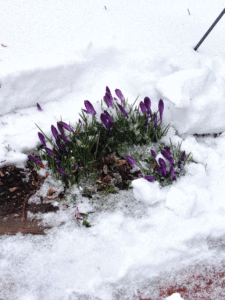
Spring bulbs like Crocus will often bloom even through the snow with the warmer temperatures and the angle of the sun. (Photo by Ginny Rosenkranz)
February can be chilly, snowy or both, but many plants don’t mind the wintery weather at all.
Some plants, however, do need a bit of attention if snow does drop too heavily out of the sky and onto our landscape.
Boxwoods have very bendable branches, but if heavy wet snow piles up on the boxwood, the branches will often bend too far and break.
Sometimes the branches look like they have bounced back, but the vascular system (or the plant’s “plumbing”) will have broken and will not look bad until the springtime temperatures warm up.
Once the plants warm up, any branches that are broken will not maintain their dark green foliage, but will turn brown and begin to dry up.
Aucuba japonica and Nandina are also southern plants that can handle all the heat and humidity our Eastern Shore summers can toss at it, but it will also break apart under a heavy snow.
The simple solution is to lightly brush the snow off of the plants with a broom after the snow storm is over.
The snow will not hurt the plants around the roots and the branches will be able to stay upright and healthy.
If branches of shrubs and small trees have been broken off by a heavy snow, it is always a good idea to remove the fallen branches and trim up the wounds that were caused by the breaking of the branches.
If the branch is no larger than a half-inch to an inch in diameter, sharp loppers can be used to trim the branch back to another branch or the main stem. If the broken branch is more than one inch in diameter, a saw should be used to cut the branch back.
Sometime the snow will start to melt and reveal a springtime beauty that will brighten up that small part of the landscape.
Spring bulbs like Crocus and Snowdrops will often bloom even through the snow as the warmer temperatures and the angle of the sun whisper that springtime is almost here.
(Editor’s Note: Ginny Rosenkranz is a commercial horticulture specialist with the University of Maryland Extension.)



